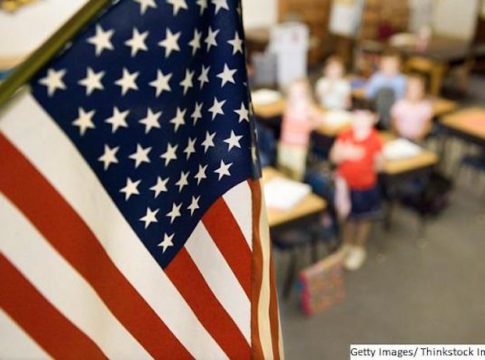In the election’s wake, Robert Pondiscio (appropriately on the staff of Democracy Prep school) asked, “Can a Redesigned AP Government Course Get Schools Back into the Civic Education Game?“: At this moment of national distaste with the process of the election, could the launch of a new version of AP Government be a propitious moment to teach civics to a much broader set of teens?
Robert concluded:
If anything, we have likely reached a fish-or-cut-bait moment for civics education in America. If we can’t commit to restoring the public purpose of public education now, we should simply stop talking about it and settle for nothing but college and job readiness—and resign ourselves to our poisoned national politics.
Ugh.
 Is AP Government the solution to our civics conundrum? Does it respond to the challenge, ably put by Bret Stephens, The System Didn’t Work? That, not just in the US, but in Britain, across Europe, and beyond, “the ‘system,’ with its high-toned rationale and its high-handed maneuvers, struck millions of people as unaccountable and unjust”? Or, conversely, would greater study of the AP framework lead a more ‘civil’ election, perhaps one with the more conventional result expected by so many?
Is AP Government the solution to our civics conundrum? Does it respond to the challenge, ably put by Bret Stephens, The System Didn’t Work? That, not just in the US, but in Britain, across Europe, and beyond, “the ‘system,’ with its high-toned rationale and its high-handed maneuvers, struck millions of people as unaccountable and unjust”? Or, conversely, would greater study of the AP framework lead a more ‘civil’ election, perhaps one with the more conventional result expected by so many?
To see, I reviewed the new AP framework, comparing it with civics as I’ve come to know it; in my own life of public employment, service and engagement.
Via this lens, AP US Government comes away as a Beltway-centric curriculum. In a day crying for sea-to-shining-sea solutions, it casts light only on what happens around the National Mall, extending its gaze not even to K Street or Arlington, let alone the workings of Middletown or Ferguson. It’s good as it goes. It needs one or more, first-rate, communities-centric, competing curricula.
To their credit, teachers across America have come to understand this. Their responses are varied and incomplete. Yet these teachers are connected to the teens and their communities, and their responses are evolving to show this.
Last week, a season-long, nationwide collaborative of teachers produced 37 finalized ideas for civic education. It’s a very different set of ideas from those in AP Government & Politics. Among them was City 2.0, “a public policy class for seniors which applies Design Thinking mindsets and skills to real world problems.” Another was “Summer Community Leadership Institute!”
To be sure they authors were a small, hastily convened, group. Yet they represent a large swath of the leader-educators I encounter.
Who is right about the future of civics education, Robert or these teachers? Both and more. It shouldn’t be an either-or proposition. Instead we should look at each graduating class as bringing a mixture of civic knowledge, skills, and questions to the adult world they join. Every community should have some new adults trained in the formalities of Federalist 51, Buckley vs Valeo and Citizens’ United. And some for whom civics tends more toward an understanding of the dynamics of cleaning up the streets surrounding their school.
When we do this—when we teach also the civics of the local and the experiential—we must not just wing the curriculum. It’s not enough to do rigorous curriculum development only for the high achievers. We ought do the same for the civics learning of the teens who will stay in East Cleveland, Appalachian Greenbrier County, WV, or Ferguson, MO. We should design new curricula for these teens, and vet them the way the College Board vets their AP frameworks. We can’t look at one as the ideal and the other as a “best we could do.” We need to see local neighborhood and community development as every bit as worthy of rigorous intellectual engagement as the structure and functioning of the Court and the US Congress.
In my life, I’ve been privileged to see many sides of civics learning. We had, in high school, a wonderful history and government teacher, the better that our bond with her lasted two full years. While our study wasn’t to the level of the current AP framework, we covered much that is in there, plus a mock trial, and much more. Later, as an undergrad, we enjoyed a great US history team, who introduced us to the detailed lives of workers in the industrial age. In grad school and beyond, I was able to study in depth the size, structure, culture, and mission of the US Army, and its ups and downs since WWII. And, we studied under some top-rated instructors in economics and finance.
Still, none of these prepared me to simply get a rustic walking trail opened. Or to finalize an initiative for a summer youth recreation leader.
What did prepare me to jump into community-building in my Appalachian county? Tough to pinpoint, and your mileage may vary, but…
…a law class, including the differences between contract and administrative law; accounting–even though government accounting is a really strange beast; a stint pulling property surveys and deeds from the courthouse files; a season of work on a Congressional campaign; familiarity with basic electric; plenty of time helping at church dinner-fundraisers; different experiences with design and print basics; a passing ability with painting, digging, and power tools; a broad vocabulary for grant- and publicity-writing; familiarity with the various departments of local and Ohio government; lots of background geographical knowledge; Robert’s Rules of Order, learned in 4-H; and plenty of practice choosing words carefully, in many situations.
Most of all, a don’t-quit attitude of problem-solving, and a passion (thank you Sister Annunciata?) for serving others.
From this perspective, the AP Government framework stands out with its extreme D.C.-centeredness. The states are but a theoretical construct, squeezed in to assure us of some vague lines of control. “We the People” and AP civics don’t really cross paths; not if you’ve worked on the ground, trying to build up facilities and the economy in a disadvantaged community.
Of course, that’s what AP AG&P is designed to be. A college-level class in US Government. Except that we’re appropriating it to serve in place of high school curriculum that never developed quite to the public aims we had for high school. (We’ve gone from tests designed to let a few teens skip a class in college, to pushing university-type courses into every nook of high school. ) We’ve mistaken rigor in a narrow domain for solid, broadly-informed, civics learning.
The AP system can best be thought of as an IBM 360 era artifact. In 1980, if you wanted to run a computer, you bought an expensive mainframe (or 1000 lb ‘mini-computer’) from IBM, Honeywell, or Univac. If their handful of engineers couldn’t imagine your needs, you didn’t need it. Or so we thought.
Civics is so much more than US government and politics: It’s the way you look at your street as either the Mayor’s or as your family’s. It’s whether you pick up some litter in the park your kids play in, or leave it be. It’s going to a school information meeting even when you have no kids in the system and serving pancakes at a pancake breakfast so you can meet the local leaders and politicians who come to hang out.
I don’t claim to know exactly how to teach this level of civics, and the levels in between. Yet I believe it’s possible.
Could a deeply vetted, widely used, quarter-credit civics class look mostly at our cities? At the history of their governance over the past century? Of the acquisition and allocation of power inside them? And the specific mandates and constraints put on them by Federal and State governments? What if we gave the same level of design effort and scrutiny AP gets to a high school class designed for the non-college-bound teen, the ones who will stay in communities and build them? What if we expended serious effort in designing hands-on, experiential, local-civics-focused learning?
What if, rather than beginning with the Congress and Supreme Court, teens began the semester by walking their neighborhoods and asking questions? What if they could then choose from a large selection of lessons and prerequisites that might help answer those questions? If some leap to the content or process of Roe v Wade or Buckley v. Valeo, fine. Yet most won’t.
Academic learning that comes to mind includes more prosaic elements of law, such as contract vs criminal vs administrative law; the developmental history of their own city; recent (50 years) political history of their city; basics of land law; current vs past thinking in urban planning; specific budgetary investigations at both the state and local level; school funding law in their state; essentials of Leadership, EPA impacts on dismantling abandoned structures; economic price theory; or the competitive strengths and weaknesses of their own city or region.
Naturally, national government seems at first much more sexy and appealing to many teens than the local board of health. It is, after all, the business of princes and queens throughout time. Studying the complete AP framework should be an option for any teen who finds it compelling.
In 2017, though, we can think very differently about what it means to learn in school. We don’t have to allot teens merely to available staff, textbooks, and rooms. We can unbundle and enhance learning as so many other sectors have unbundled and enhanced their offerings. We can consider not just a President-down perspective, but a neighborhood-up one. And we can allow for teens to have more options in between.
With such unbundling comes the opportunity for teens to iterate their learning much more frequently. To allow teens to jump into civics learning not just as a senior course, but early on. To test different ways of learning (games, VR, AR, role-playing) and different domains of civic knowledge. To revisit the civics realm ( and accumulate permanent micro-credentials) throughout their high school career.
If it seems like I’m introducing a lot here, I am. Because we have new options of how teens might learn, and thus when and where they can learn, we can also greatly reconsider what they (individually and collectively) might learn.
My Appalachian neighbors are very experiential in their thinking; they don’t readily adopt theories learned decades ago into their opinions of events going on today. So it’s fair to ask: why is it I got the experiential learning in school, while they were mostly stuck with the scraps off the buffet of civic learning I enjoyed? How do we give them so much more, and still make sure they’re getting solid, widely-shared, intellectually-enhancing curricula?
Competing, experiential, rethought civics curriculum should not, however, be merely for those not destined to Georgetown. Our future national leaders could use with much more local community-building civics as well.
As to election 2016, to be honest, I find the cure to be more bars of soap in the mouths of 10-year-olds and more slaps by wives at husbands who are publicly vulgar.
Yet I also sense that we need a crowd of public writers and policy-makers who would not have been shocked at 11 PM, Tues, Nov. 8th. One way to begin that is to put civilians back into high school civics education.
Ed Jones leads the Hackable High Schools initiative. He is bootstrapping a Statewide Experiment in Customized Teen Learning, an effort to test new, open sourced curricula under Ohio’s Credit Flex law.




